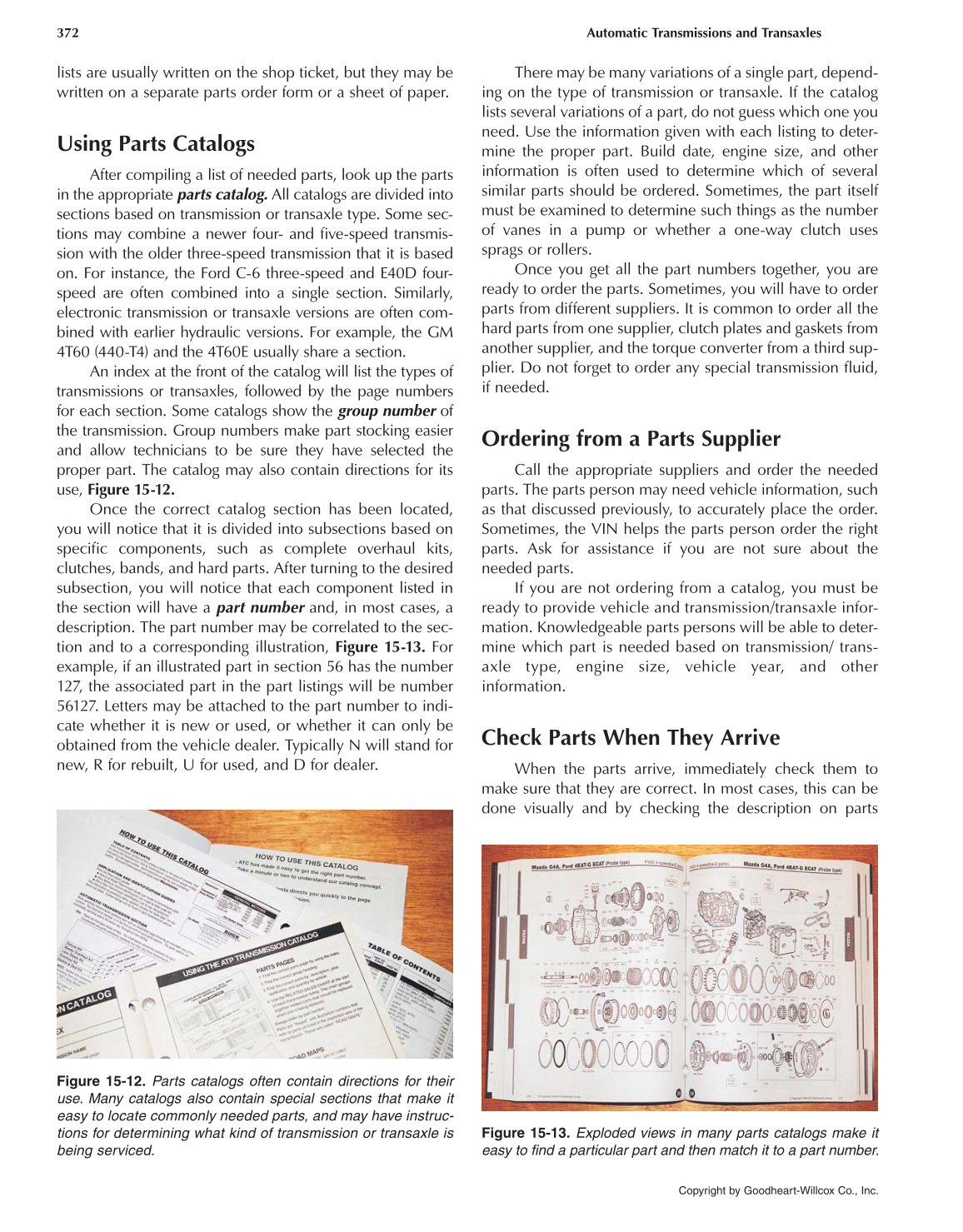Copyright by Goodheart-Willcox Co., Inc.
372 Automatic Transmissions and Transaxles
Figure 15-12. Parts catalogs often contain directions for their
use. Many catalogs also contain special sections that make it
easy to locate commonly needed parts, and may have instruc-
tions for determining what kind of transmission or transaxle is
being serviced.
Figure 15-13. Exploded views in many parts catalogs make it
easy to find a particular part and then match it to a part number.
lists are usually written on the shop ticket, but they may be
written on a separate parts order form or a sheet of paper.
Using Parts Catalogs
After compiling a list of needed parts, look up the parts
in the appropriate parts catalog. All catalogs are divided into
sections based on transmission or transaxle type. Some sec-
tions may combine a newer four- and five-speed transmis-
sion with the older three-speed transmission that it is based
on. For instance, the Ford C-6 three-speed and E40D four-
speed are often combined into a single section. Similarly,
electronic transmission or transaxle versions are often com-
bined with earlier hydraulic versions. For example, the GM
4T60 (440-T4) and the 4T60E usually share a section.
An index at the front of the catalog will list the types of
transmissions or transaxles, followed by the page numbers
for each section. Some catalogs show the group number of
the transmission. Group numbers make part stocking easier
and allow technicians to be sure they have selected the
proper part. The catalog may also contain directions for its
use, Figure 15-12.
Once the correct catalog section has been located,
you will notice that it is divided into subsections based on
specific components, such as complete overhaul kits,
clutches, bands, and hard parts. After turning to the desired
subsection, you will notice that each component listed in
the section will have a part number and, in most cases, a
description. The part number may be correlated to the sec-
tion and to a corresponding illustration, Figure 15-13. For
example, if an illustrated part in section 56 has the number
127, the associated part in the part listings will be number
56127. Letters may be attached to the part number to indi-
cate whether it is new or used, or whether it can only be
obtained from the vehicle dealer. Typically N will stand for
new, R for rebuilt, U for used, and D for dealer.
There may be many variations of a single part, depend-
ing on the type of transmission or transaxle. If the catalog
lists several variations of a part, do not guess which one you
need. Use the information given with each listing to deter-
mine the proper part. Build date, engine size, and other
information is often used to determine which of several
similar parts should be ordered. Sometimes, the part itself
must be examined to determine such things as the number
of vanes in a pump or whether a one-way clutch uses
sprags or rollers.
Once you get all the part numbers together, you are
ready to order the parts. Sometimes, you will have to order
parts from different suppliers. It is common to order all the
hard parts from one supplier, clutch plates and gaskets from
another supplier, and the torque converter from a third sup-
plier. Do not forget to order any special transmission fluid,
if needed.
Ordering from a Parts Supplier
Call the appropriate suppliers and order the needed
parts. The parts person may need vehicle information, such
as that discussed previously, to accurately place the order.
Sometimes, the VIN helps the parts person order the right
parts. Ask for assistance if you are not sure about the
needed parts.
If you are not ordering from a catalog, you must be
ready to provide vehicle and transmission/transaxle infor-
mation. Knowledgeable parts persons will be able to deter-
mine which part is needed based on transmission/ trans-
axle type, engine size, vehicle year, and other
information.
Check Parts When They Arrive
When the parts arrive, immediately check them to
make sure that they are correct. In most cases, this can be
done visually and by checking the description on parts
